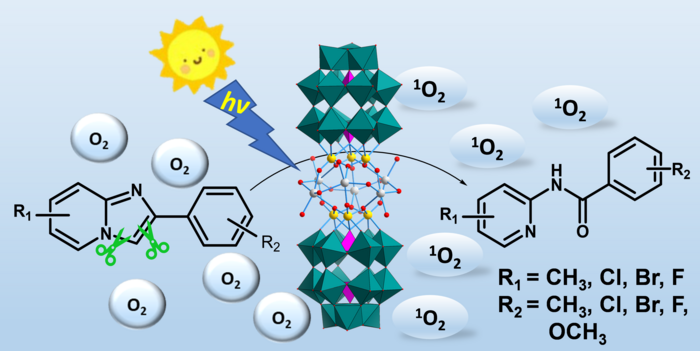Cracking carbon bonds is an extremely challenging problem—however, it might pave the way for producing greener, more sustainable chemicals.
 A Chinese research team synthesized silver-modified polyoxometalates and achieved the first example of visible-light-promoted simultaneous cleavage of C-C bond and C-N bond catalyzed by a POM photocatalyst. Image Credits: Polyoxometalates, Tsinghua University Press
A Chinese research team synthesized silver-modified polyoxometalates and achieved the first example of visible-light-promoted simultaneous cleavage of C-C bond and C-N bond catalyzed by a POM photocatalyst. Image Credits: Polyoxometalates, Tsinghua University Press
A research group from China attained the first visible-light-promoted simultaneous cleavage of carbon-nitrogen and carbon-carbon bonds through a silver-modified polyoxometalate photocatalyst, which unlocks avenues for applications such as carbon-neutral substitutes for fossil fuels. The results of this research were published on March 3rd, 2023, in Polyoxometalates.
Photocatalytic technology is highly efficient and cheap. It is being employed to solve increasingly adverse environmental pollution problems. Polyoxometalates (POMs), a class of metal-oxide clusters, exhibit unique physicochemical characteristics—making them especially efficient in the photocatalysis field, which uses light energy to drive a chemical reaction.
As photocatalysts, POMs can break down organic pollutants present in wastewater and decrease carbon dioxide due to their reversible redox properties and molecular structures’ stability. Along with bond formation reactions of carbon-nitrogen (C-N) and carbon-carbon (C-C), POMs could also catalyze simple organic transformations.
The majority of the POMs, however, can function only with ultraviolet light.
It is of great significance to design and synthesize new visible-light-promoted POMs photocatalysts and explore their potential in new organic reactions.
Shujun Li, Study Lead Author, Henan Normal University
With this aim—to wield in selective, simultaneous carbon bond cleaving—Li and coworkers analyzed synthesizing visible-light promoted POMs photocatalysts.
C-C and C-N bonds are the most widespread and fundamental bonds existing in organic compounds. Selectively catalytic cleavage of C–C bonds or C–N bonds for chemical transformations is an important topic in synthetic chemistry and has become one of the most attractive but challenging tasks.
Shujun Li, Study Lead Author, Henan Normal University
Chemists have continued this aim for the last few years as cracking these persistent bonds may pave the way for identifying valued new chemicals or greener approaches to make already recognized ones. Likewise, to cleave C–N bonds or C–C bonds independently, they have created a varied range of catalytic systems. Cleavage of both C–N and C–C bonds in a single organic transformation is, however, a difficult goal.
“Few examples of simultaneous cleavage of C-C and C-N bonds in one substrate molecule have been reported so far,” Li stated.
Extreme reaction conditions, like strong oxidizing or initiating agents and high temperatures, are required by rapid, simultaneous cleavage of these types of bonds to complicate things further.
To achieve a silver-modified polyniobotungstate (Ag-Nb/W), the team combined niobium (Nb)/tungsten (W) mixed-addendum POM and silver (Ag) ion.
In the visible region, Ag-Nb/W exhibited strong absorption, motivating scientists to analyze its catalytic activity in visible light. The study of researchers included an examination of substrate scope and bounds of conditions for ideal operation, along with the reusability and stability of Ag-Nb/W.
The finding showed that the structure and synthesis of Ag-Nb/W aids in efficient catalysis to simultaneously cleave C–N and C–C bonds in mild conditions under visible light. Besides, Ag-Nb/W can be reused a maximum of six times without a reduction in the catalytic activity.
To the best of our knowledge, this is the first example of visible-light-promoted simultaneous cleavage of C-C bond and C-N bond catalyzed by a POM photocatalyst, which coincides with the social demand for green chemistry and sustainable development.
Shujun Li, Study Lead Author, Henan Normal University
This study offers a possible revelation for developing new visible-light-induced polyoxometalates photocatalysts to be employed in organic reactions that involve the cleavage of C–N and C–C bonds, addressed Li.
As a next move, the scientists plan to integrate this compound with other solid carriers to develop a more stable and dispersed photocatalytic material ideal for its usage in photocatalysis.
The study was funded by the National Natural Science Foundation of China and the Program for Science & Technology Innovation Talents in Universities of Henan Province.
Other contributors are Na Li, Gang Li, Yubin Ma, Mengyao Huang, Qingchun Xia, Qianyi Zhao, and Xuenian Chen from Henan Normal University. Chen is also affiliated with Zhengzhou University.
Journal Reference:
Li, S., et al. (2023) A silver-modified polyniobotungstate for visible-light-induced simultaneous cleavage of C-C and C-N bonds. Polyoxometalates. doi.org/10.26599/POM.2023.9140024.